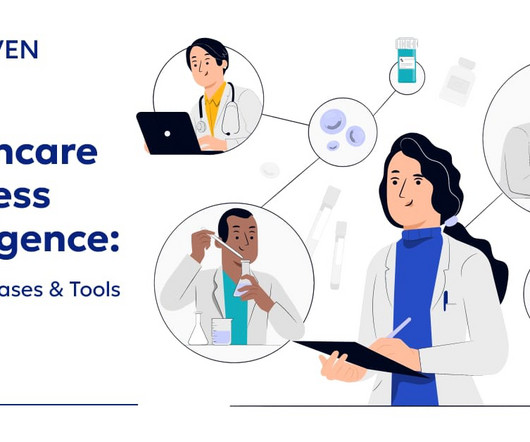Pharmacy in the Digital Age
Drug Topics
JUNE 17, 2024
The world’s information is at our fingertips, but understanding that information and applying it to patient care still requires a rigorous education.
This site uses cookies to improve your experience. To help us insure we adhere to various privacy regulations, please select your country/region of residence. If you do not select a country, we will assume you are from the United States. Select your Cookie Settings or view our Privacy Policy and Terms of Use.
Cookies and similar technologies are used on this website for proper function of the website, for tracking performance analytics and for marketing purposes. We and some of our third-party providers may use cookie data for various purposes. Please review the cookie settings below and choose your preference.
Used for the proper function of the website
Used for monitoring website traffic and interactions
Cookies and similar technologies are used on this website for proper function of the website, for tracking performance analytics and for marketing purposes. We and some of our third-party providers may use cookie data for various purposes. Please review the cookie settings below and choose your preference.

Drug Topics
JUNE 17, 2024
The world’s information is at our fingertips, but understanding that information and applying it to patient care still requires a rigorous education.

IDStewardship
JANUARY 8, 2025
Pharmacy residents have the chanceto practice at the top of their license and deliver outstanding patient care. Keeping the patient at the center of our mission allows us to devote our time and energy towards developing patient care skills. Learning takes practice and repetition. References 1. Mcelhaney A, Weber R.
This site is protected by reCAPTCHA and the Google Privacy Policy and Terms of Service apply.

STAT
OCTOBER 23, 2023
Almost as soon as ChatGPT was released to the public, doctors began focusing on how they could harness artificial intelligence to improve patient care. Yet even as AI is providing doctors with increasingly sophisticated data, the information available to patients has stagnated. And what is available is often years old.

pharmaphorum
MARCH 23, 2021
Repeat information, either through tests or spaced repetitions. If these concerns can be effectively addressed and large-scale studies can show clinical significance, the use of gamification in patient care will continue to rise exponentially. Evoke intrinsic and extrinsic motivation. Incorporate progress mechanics.

European Pharmaceutical Review
JANUARY 7, 2025
FDA has previously published a discussion paper that was produced to inform its guidance on AI in pharmaceutical drug development. With the appropriate safeguards in place, artificial intelligence has transformative potential to advance clinical research and accelerate medical product development to improve patient care.

pharmaphorum
AUGUST 4, 2021
This means patients may be forced to travel considerable distances to get treatment, which can cause significant strain on their physical and emotional wellbeing, and that of their caregivers. This lack of clarity can delay diagnosis and treatment, meaning suboptimal care for patients. About the author.

STAT
MARCH 7, 2025
After yet another record year for health data breaches, updated federal security rules to protect patient information are on the table in 2025. Increased privacy protections, in their view, would impact the financial viability of medical practices — especially small ones — and even timely patient care.

Pharmacy Is Right For Me
JUNE 30, 2023
Discover how embracing one’s identity can enhance patient care and create a positive impact within the pharmacy field. The universal rationale of being able to be actively involved in patient care certainly applies to my own experience as well!”

Fierce Healthcare
MAY 21, 2024
. | Founded in 2015, Tempus says it’s built the world’s largest library of clinical and molecular data along with an operating system to make those data accessible and useful for providers to inform patient care.

Pharmacy Is Right For Me
JANUARY 3, 2024
Versatility in Pharmacy Clinical pharmacists occupy a distinctive position, often granted patient care privileges that allow them to engage in comprehensive medication decision-making functions as integral members of the healthcare team. ¹ This is especially true when I call patients on the phone.” About Clinical Pharmacists.

IDStewardship
DECEMBER 12, 2023
The risks of AI are not going to be discussed in detail here, but it should be noted that pharmacists should beware policies of their employer(s) and avoid sharing any patient health information, trade secrets, private academic information, or other protected content onto AI platforms such as ChatGPT.

IDStewardship
NOVEMBER 29, 2023
BCPS, BCIDP Article Posted 1 December 2023 Podcasting has emerged as an incredible way to reach a global audience and discuss scientific information. It is an incredibly important field for the advancement of patient care today. They are very valuable because they provide information in a way that is readily accessible.

pharmaphorum
DECEMBER 4, 2024
Discover how driving innovation in multiple myeloma treatment can positively impact the patient experience. Stay informed on the latest advancements in cancer research and patient care.

STAT
OCTOBER 10, 2024
With just months to go before the ability to prescribe controlled substances online dramatically changes overnight, the vacuum of information is forcing them to devote significant energy preparing for the unknown. Continue to STAT+ to read the full story…

Board Vitals - Pharmacist
JULY 24, 2024
One of the most significant advancements in recent years is the rise of teledermatology, a subspecialty that combines telehealth with dermatological care. It involves the use of telecommunications technology to exchange medical information concerning skin conditions and diseases. The post How is Teledermatology Changing Patient Care?

STAT
JULY 25, 2024
The Office of the National Coordinator for Health Information Technology, better known as ONC, regulates data standards for health care systems, including the electronic health records that underpin patient care and billing.

Fierce Healthcare
AUGUST 31, 2023
The American Telemedicine Association, the College of Healthcare Information Management Executives (CHIME) and Otsuka America Pharmaceutical are among the groups in support of the Centers for Medic | Organizations signed a letter pledging support for a CMS-backed transitional coverage for emergency technologies pathway, which they say could improve (..)

STAT
JANUARY 10, 2024
researchers reported their findings from more than 13,800 solid tumors in adults, detailing that certain tumors were more likely to carry mutations that could inform patient care, whether by steering treatment choices or indicating a potential familial risk. In a paper published Thursday morning in the U.K.,

IDStewardship
FEBRUARY 25, 2024
While the global AMR statistics are powerful, having local data makes information more relatable and actionable. Medical Advisor, bioMérieux Chat participants also shared that institution-specific data resonate best with providers when it comes to prescribing and direct patient care. In my practice, we always reported the MIC.

IDStewardship
JUNE 6, 2023
Patient Education and Adherence : AI chatbots or virtual assistants can be developed to provide patients with on-demand information about their medications, dosages, potential side effects, and adherence strategies. This empowers patients to make informed decisions and fosters better medication adherence.

Pharmaceutical Commerce
FEBRUARY 5, 2024
Pharma Commerce travels to Orlando for a pulse-check on this fast-evolving landscape in patient care.

Viseven
MARCH 25, 2025
In healthcare, business intelligence plays an especially important role, as it can be used to create better treatments, personalize patient care, prevent diseases, keep patients’ personal info safe, and even detect fraud. Healthcare business intelligence software is a must-have for any organization in the industry.

Pharma Marketing Network
JULY 27, 2022
The patient care team supplies an abundance of information, although sifting through brochures and online resources can be daunting for the patient and their caregiver. 1 The marketer’s goal is to design easy-to-follow patient guidelines while conforming to med-legal language. And the Future Looks Like….

Pharmacy Is Right For Me
JANUARY 18, 2024
A pharmacy education provides diverse opportunities, ranging from patient care and research to education. And if you’re interested in a similar path, explore the Pharm4Me website for more information on becoming a pharmacist and discover additional inspirational stories on the Pharm4Me Blog.

IDStewardship
MARCH 23, 2023
Laboratorians, clinicians, and other healthcare professionals engaged to discuss the importance of essential tools for rapid diagnostics and stewardship data for effective patient care to help save lives—particularly when dealing with drug-resistant infections. You can find him on Twitter @Brian_Raux.

pharmaphorum
JUNE 22, 2022
Truveta’s platform is based on electronic medical record data – updated daily – for more than 50 million people in the US, harvesting anonymised patient care information from tens of thousands of clinical care sites across 42 states.

Hospital Pharmacy Europe
MAY 22, 2024
Penicillin allergy is a common concern in healthcare settings, impacting patient safety, antimicrobial stewardship and successful infection treatment. In developed countries, between five and 15% patients carry a penicillin allergy label , and patients receive a penicillin allergy label by their third birthday in approximately 75% of cases.

Hospital Pharmacy Europe
MARCH 31, 2025
By doing this, they can greatly influence both patient care and environmental sustainability, re-affirming the crucial role of sustainability in the future of healthcare. J Am Med Inform Assoc 2024;31(3):73245. Self-reported digital literacy of the pharmacy workforce in North East Scotland. Pharmacy (Basel) 2015;3(4):18296.

pharmaphorum
JANUARY 27, 2021
It’s one that has global potential to improve patient outcomes but efforts to harness the true potential of these information flows are only just beginning. A unique health data ecosystem for improving patient care. Uncovering new ways to improve NHS patient care. Generating RWE to support oncology research.

Hospital Pharmacy Europe
MARCH 18, 2025
A multidisciplinary focus As clinical pharmacy continues to evolve, there is increasing emphasis on how roles and responsibilities enhance patient care through a multidisciplinary approach, particularly in hospital settings. The integration of pharmacists into specialist care teams is a model she believes should be more widely adopted.

pharmaphorum
OCTOBER 27, 2020
Collecting and analysing anonymised patient data has the potential to generate valuable insights that can catalyse research, lead to improved patient care, and power the development of new treatments. This is because typically, ‘real-world’ medical data is collected from patients who are ill.

pharmaphorum
JUNE 10, 2022
Pharma’s evolving role in patient care. Pharma’s digital initiatives now routinely enable new channels that educate and market to patients, physician engagement that is more efficient and effective, and novel payment mechanisms and distribution models that improve access to therapies. The possibilities are nearly limitless.

pharmaphorum
JANUARY 12, 2022
Roche has launched what it says is a first-of-its kind handheld glucose management device, backed up by a digital platform that aims to simplify the work of doctors and nurses as they deliver care to patients.

Hospital Pharmacy Europe
MARCH 14, 2025
We are excited to share that the latest Clinical Excellence in Respiratory Care event will take place virtually on 7 May 2025. This free, one-day conference is a must-attend event for healthcare professionals looking to stay informed on the latest clinical advancements in respiratory care.

The Happy PharmD
MARCH 25, 2025
It includes roles like Medical Science Liaisons (MSLs), who engage with providers, and Medical Information Specialists, who answer complex drug-related questions. The biggest challenge isnt the job marketits recognizing that the skills youve built over years of patient care translate directly into these positions.

indispensable health
AUGUST 14, 2023
Introduction In the fast-paced and intricate world of healthcare, seamless coordination between various departments is crucial to ensure quality patient care and effective administration. Every minute saved can be channeled into making strategic decisions, enhancing patient care, or addressing critical issues.

DiversifyRx
APRIL 18, 2024
In the hustle of pharmacy management, providing exceptional patient care and ensuring high levels of customer satisfaction are top priorities for pharmacy owners. As a pharmacist or pharmacy owner, you already know the importance of delivering top-notch patient care and creating positive experiences for them.

STAT
JULY 17, 2023
Big businesses poised to profit from the advance of artificial intelligence in health care are pushing back against newly proposed federal rules meant to increase oversight and fairness of AI tools used to help make decisions about patient care.

Omnicell
JANUARY 10, 2023
From institutional operations and data management to technological resources and care providers, systemness is all the components of healthcare working together as one. All parts share a common goal and derive information from the same source. Besides reducing risk, systemness improves the overall quality of patient care over time.

Pharma Marketing Network
JULY 19, 2023
This could include sponsoring research into new drugs and treatments, providing educational resources about health conditions, or supporting patient care programs. For example, Merck, another leading pharmaceutical company, has a website that provides information about a variety of health conditions.

IDStewardship
SEPTEMBER 2, 2022
In this article an expert in clinical information design provides his insights, discussing reasons why some guidelines do not get used along with solutions to these problems. I recently had the opportunity to meet and speak with Dr. Michael Long, who is an expert in clinical information design. Interview with: Michael Long, Ph.D.

PQA
MARCH 12, 2025
Then, in August 2024, PQA released the Advancing Medication Therapy Management Quality Measurement report informed by public comments solicited from PQA members and MTM stakeholders. A draft call to action was created using findings from an environmental scan and a PQA Convenes event.

Digital Pharmacist
JULY 11, 2023
By diversifying services and embracing a patient-centered approach, independent pharmacies can position themselves as vital healthcare hubs within their communities. One effective strategy to achieve this is by offering top-notch clinical services that not only enhance patient care but also contribute to a significant revenue boost.

pharmaphorum
JANUARY 22, 2023
A well-designed and thought-out digital solution, with a considered user experience, can deliver a better service and support HCPs to deliver positive patient outcomes, whilst strengthening relationships between pharma companies and their HCP networks. How can this impact patient care? What is meant by an HCP portal?
Expert insights. Personalized for you.
We have resent the email to
Are you sure you want to cancel your subscriptions?


Let's personalize your content